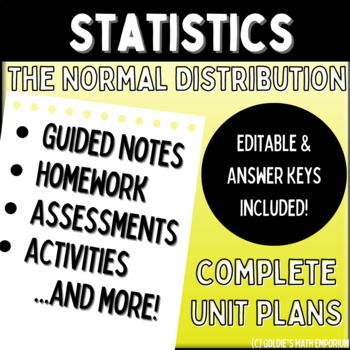Statistics: The Normal Distribution
- Zip
What educators are saying
Also included in
- Statistics: Full Curriculum This is the FULL CURRICULUM bundle for my regular-level, Statistics course. If you are looking for my full curriculum for AP Statistics, follow the link here. This full curriculum is six units long and lasts 1 semester, approximately 90 school days. The following units arPrice $99.00Original Price $120.00Save $21.00
Description
Statistics
Unit 2: The Normal Distribution
Complete Unit Bundle
Welcome! This is the complete unit plan for the second unit in my regular level Statistics class. (If you are interested in the AP Statistics Unit 1 Plans, check out my listing here.)
Included in this resource:
- 6 complete sets of student-guided notes (annotated answer keys included)
- 7 homework problem sets + complete test review (annotated answer keys included)
- 2 assessments – quiz and test (answer keys included)
- 2 in-class review PowerPoint presentations
- 3 activities (including a trivia review game)
- 1 project
- Suggested pacing and learning targets
All of the resources are 100% editable, to modify to fit your classroom needs. The zip folder includes the Word document, which you have permission to edit completely. The PDF version and answer keys are included for your convenience. There are also PowerPoint presentations for some of the review documents.
I teach this course without a textbook, so everything that is provided here, can be used without supplementation.
******************************************************************************
The student-friendly learning targets for this unit are:
- Students will be able to graph a normal curve and summarize its important properties
- Students will be able to use the empirical rule to estimate population percentages of a normal distribution.
- Students will be able to calculate, interpret, and compare the z-scores among a population.
- Students will be able to estimate population percentages of a standardized normal distribution.
- Students will be able to estimate raw data given percentages of a standardized normal distribution.
- Students will be able to use the empirical rule to prove if a data set fits a normal distribution.
The Common Core Math Standards covered in this unit are:
- ID.A.4: Use the mean and standard deviation of a data set to fit it to a normal distribution and to estimate population percentages. Recognize that there are data sets for which such a procedure is not appropriate. Use calculators, spreadsheets, and tables to estimate areas under the normal curve.
******************************************************************************
My regular level Statistics course includes the following units:
Unit 2 – The Normal Distribution
Statistics: Full Semester Curriculum Bundle (Units 1 – 6)
Unit 7 – Sampling Distributions
Unit 8 – Confidence Intervals (Coming Soon!)
Unit 9 – Hypothesis Testing (Coming Soon!)
Unit 10 – Comparing Two Populations (Coming Soon!)
Unit 11 – Chi-Square Distributions (Coming Soon!)
******************************************************************************
Q: How is this different from my AP Statistics Unit 1 Unit Plans?
A: My AP Stat Unit 1 plans follow the AP Stat CED, which covered one-variable statistics as well as the Normal Distribution in 16 days. The pace is quicker, the notes are longer, and the questions are modeled off of the AP Exam questions. My new Statistics Unit 2 covers only the Normal Distribution in 11 days, is slower-paced with shorter notes, and it has questions to help build a functional understanding of the listed learning targets.
Q: Can I use your AP Statistics materials in my on-level (regular level) Statistics course?
A: Absolutely! These unit plans fit a semester-long course in Statistics. My AP Statistics unit plans would fit perfectly for a year-long Statistics course. You can check out the full curriculum here. If you have more questions about the differences and want some help deciding what would work best in your class, please feel free to reach out via email or Q&A on TPT!
******************************************************************************
If you need extra explanations or additional guidance, I would love to help!! Contact me at goldiesmathemporium[at]gmail.com for any questions or samples.
I want to provide the best possible resources to help other teachers out! You will be notified of any future updates and additions to this product and it will be free of charge. Your support is important and I thank you for allowing me to continue doing what I love to do.
Note: I am not affiliated with nor endorsed by any textbook or other curriculum provider. I am a classroom teacher who creates curriculum materials to help other teachers.
© Goldie’s Math Emporium, LLC
This work is bound by copyright laws and editing (beyond your own classroom use), selling, redistributing, or posting all or part of these documents on the Internet is strictly prohibited. Violations are subject to the Digital Millennium Copyright Act.



